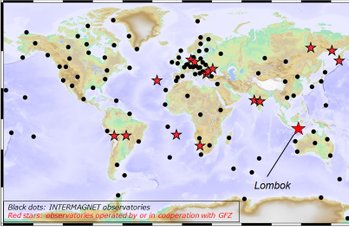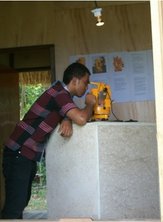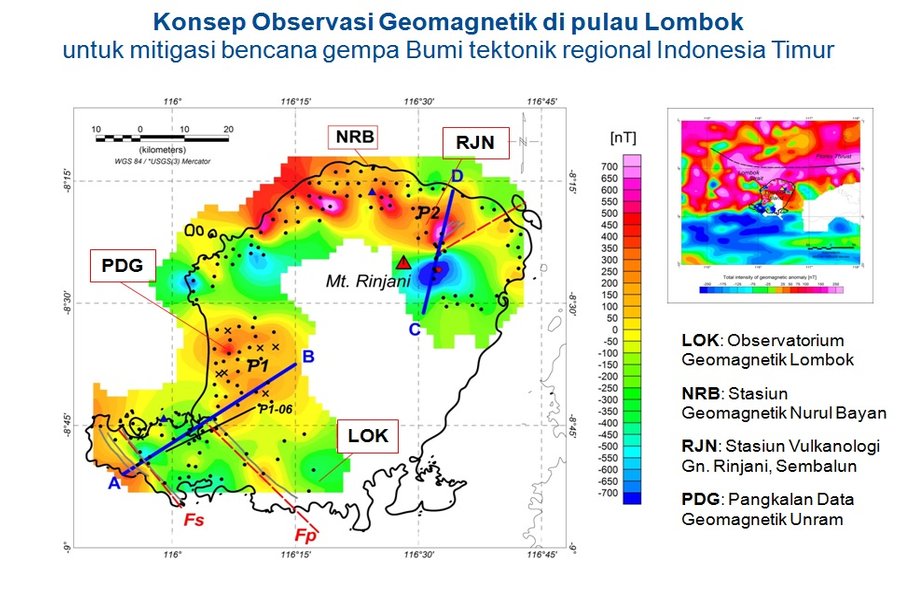Geomagnetic Observatory is an essential facility for long time and continuous observation of “Earth’s magnetic fields“. Earth’s magnetic fields play an important role in shielding the Earth from cosmic rays, especially strong radiations due to solar winds. Without these fields, it will become impossible to have the Earth is a secure planet for living organism including human kinds.
Global geomagnetic observation currently directed mostly to monitor the intensities of Earth’s magnetic fields, which going to be weaker, showing a trend of continuous decreasing. It is supposed as a clear indication of upcoming geomagnetic pole reversal. Based on magnetic directions as recorded on the rocks, the last geomagnetic reversal has happened more than 800,000 years ago; while previous reversals were only in 250,000 years intervals.
Geomagnetic observation in Lombok Island is very important, because of its special geographical location, which is in between high intensities of contiguous positive-negative anomalies. The research team of Mataram University have taken geomagnetic regional surveys and found some extreme dipolar structures, which can be linked to specific geological features of this island (igneous intrusions, mineralization, and geothermal potential) and/or regional tectonic settings (active faults and subduction, which can trigger tectonic earthquakes over this region.
Construction of the Lombok Geomagnetic Observatory consists of three buildings:
1. Main Building
It is the control room where all measurement activities are monitored and the data are stored in a server using a data logger MAGDALOG (manufactured by GFZ Potsdam, Germany). The data are then transferred in nearly real time to two servers at the Mataram University and at the Niemegk Observatory in Germany.
2. Variation Room
It is a fully non-magnetic room where Earth’s magnetic fields variations are measured continuously (ts = 0.5 sec) using:
- Three-axial suspended fluxgate magnetometer FGE (manufactured by DMI Copenhagen, Denmark), which measures geomagnetic variations in three directions of vector components (Horizontal, Declination, and Vertical).
- Overhauser proton magnetometer GSM90-F1 (manufactured by GEM Systems, Richmond Hill, Canada), which measures geomagnetic total intensities.
- GPS clock Telecode (manufactured by Precitel Neuchatel, Switzerland), which determines time automatically, synchronized with Universal Time Coordinate (UTC) using satellite.
3. Absolute House
It is a small non-magnetic room where absolute measurements are conducted periodically (weekly), using:
- DI-flux magnetometer, consists of Non-magnetic Theodolite THEO 010B (manufactured by Carl Zeiss Jena) and Fluxgate magnetometer Model MAG01H (manufactured by Bartington, United Kingdom), which measure Declination and Inclination to determine the angle between horizontal component and geographical (true) North; and the angle between geomagnetic total component and horizontal plane.
- Overhauser proton magnetometer GSM-19 (manufactured by GEM Systems, Richmond Hill, Canada), which measures absolute geomagnetic total intensity for determination of base line values.
Geomagnetic Observatory benefits:
- Observing the intensity of geomagnetic field and its changes (in long term) which are necessary in anticipating the reversal of Earth’s magnetic poles.
- Providing declination and inclination data, indispensable as a guide for navigating the aircraft and naval vessels.
- Providing estimations of magnetic storms occurrences, indispensable for radar and satellite communications.
- Providing reference data to reduce regional magnetic survey data, which can be used for mapping natural resources (geothermal, oil, gas and minerals).
- Mitigation of natural disasters (especially tectonic earthquake and volcanic eruptions), performed by processing the geomagnetic data integrated with other geophysical data, especially regional seismic activity data.
Development Plan:
- Developed as Geomagnetic Research Center, where a variety of conferences, workshops and seminars can be held.
- As an object of study and educational tours that can be used by wider community for better understanding of natural phenomena related to the Earth's magnetism.
- Processing geomagnetic survey data, to optimize the exploration of natural resources (geothermal, oil, gas and minerals).
- Development of geomagnetic data transmission equipment in nearly real-time, for mitigation of natural disasters, particularly regional tectonic earthquakes over eastern Indonesian regions.
Data from the Lombok Geomagnetic Observatory and the Geomagnetic Monitoring Station at Nurul Bayan (North Lombok) will be transmitted simultaneously to the Geomagnetic Data Server at the Department of Electrical Engineering of Mataram University. These data are then integrated with seismic data from the volcanology station at Sembalun Lawang village (East Lombok). All available data are quite essential for a continuous regional earthquake monitoring.

















